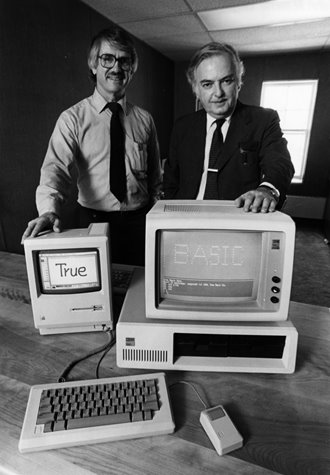By James O.
In the 1960s, two Dartmouth professors, John G. Kemeny and Thomas E. Kurtz, sought to revolutionize computer science education. They developed a programming language called BASIC, or Beginners All-purpose Symbolic Instruction Code, and distributed this language on the university network that they also developed, the Dartmouth Time-Sharing System (DTSS). Through the proliferation of this unprecedentedly easy-to-use programming language, Kemeny and Kurtz forever changed computer science curriculums around the world. Here are five ways their influence is still felt today:
BASIC made ease-of-use a primary concern
In the early days of computing, an intimate knowledge of programming was required to be able to use a computer at all. There was not yet a programming language that catered to beginners and so computer use was limited to those who had considerable patience and time and physical access to a terminal--typically at their school or place of work. And though user-friendliness seems like an obvious feature for any software, BASIC had its early detractors who claimed that its simplicity might reinforce bad programming practices. BASIC’s commands were much closer to plain English than the languages that preceded it, using commands like PRINT, LIST, RUN, END, and SAVE. This ease-of-use contributed to its proliferation upon its release in the 1960s. This spirit of accessibility still pervades the world of hobbyist microcontrollers and modern educational languages like MIT’s Scratch.
Learn to code in Scratch or other educational languages with Living Computers’ Online Education Resources!
It was an early example of real-time programming
Though we take the immediacy of modern computer interactivity for granted, in the early days, programmers often wrote their programs on stacks of punch cards, dropping them off for a technician to process with the actual computer. This often took over night or longer. The time-sharing system that BASIC originally ran on, DTSS, was an early time-sharing system at Dartmouth that allowed a single computer to multitask, quickly cycling through processes from multiple users, creating a cohesive and interactive way of using computers. DTSS enabled many students to learn how to program at once, allowing computer science curriculums to flourish. Eventually, time-sharing gave way to the age of the personal computer, but it was instrumental in prefiguring the interactive environments that we are familiar with today.
BASIC made computing cheaper for students
Before DTSS and BASIC, computers were objects of mystery to much of society, reserved for use by only a privileged few. Mainframe computers were very expensive and the processing time required to run programs was a valuable commodity. And while DTSS was not the first time-sharing system, Kemeny and Kurtz, motivated by their vested interests in widespread digital literacy, made their system with students in mind. The two professors aggressively lobbied the Dartmouth board to ensure that DTSS was free for students to use. Additionally, the two convinced Dartmouth to fund the project, purchase a GE-225 mainframe computer system, and include computer science as a requirement.
 Living Computers’ engineer Josh D. recently completed a restoration of the historic timesharing operating system, TSS/8, now up-and-running on our DEC PDP-8/e. Connect to our 8/e via our free remote online systems and program in BASIC on a real timesharing OS running on authentic vintage hardware!
Living Computers’ engineer Josh D. recently completed a restoration of the historic timesharing operating system, TSS/8, now up-and-running on our DEC PDP-8/e. Connect to our 8/e via our free remote online systems and program in BASIC on a real timesharing OS running on authentic vintage hardware!
BASIC fostered a grass-roots attitude
Because of its relative accessibility and popularity amongst students, BASIC made hobbyists out of anyone with even a little bit of curiosity about computers, especially once the advent of the personal computer further spread the language. During BASIC’s heyday, hobbyists all over the United States began to wrote their own compilers and interpreters, building their own variations of the language. The BASIC system commands spread and were expanded upon so much so that the extended BASIC family of languages defies standardization. This collaborative grassroots approach still exists today as evidenced by generations of self-taught programmers and the endless open-source repositories on websites like GitHub.
BASIC made programming fun for all!
Dartmouth’s craze for BASIC is well documented. A
New York Times article about DTSS and BASIC noted that “Dartmouth College is a campus gone crazy for computers.” DTSS spread to colleges all over the United States via the Kiewit network and boasted a user base of 13,000 students by 1971. And because BASIC was developed to be so easy a kid could use it, its later proliferation in high schools fostered generations of life-long hobbyists and career programmers alike. Computer magazines in the 70s and 80s published source code to BASIC video games and programs, allowing hobbyists to type in and analyze the code themselves. Publications like
Learn to Program Basic and David H. Ahl’s
Creative Computing as BASIC Computer Games began to use gaming as a gateway to learning to code. This approach is very much present today in computer science curriculums like those developed by Microsoft MakeCode Arcade and Adafruit.
Today, computer science education is more important than ever. The clear influence of Kemeny and Kurtz’s efforts in the 1960s is still seen today from college campuses to online courses to coding boot camps. BASIC and DTSS are in many ways the origin of our current attitudes towards widespread computer literacy. With platforms like
CodeAcademy, events like Code.org’s
Hour of Code, and visual languages like
Blockly and
Scratch, BASIC’s ethos continues to resound with new generations.
Related content:
Recreating Solitaire in BASIC (Or At Least Trying To...)
BASIC Ain’t Basic: Adapting Programs from One Vintage System to Another
[MS@45] The PDP-10, Macro-10, and Altair 8800 BASIC